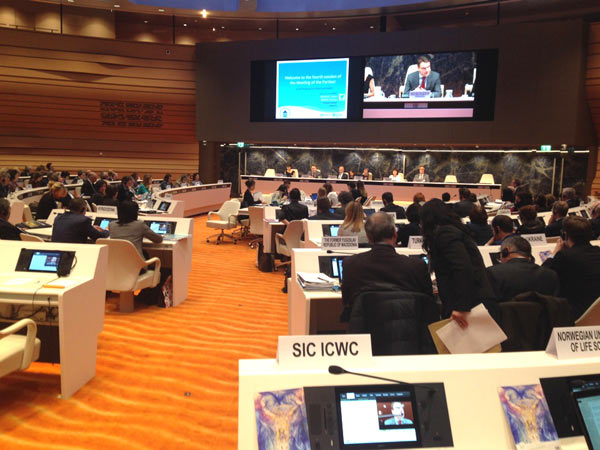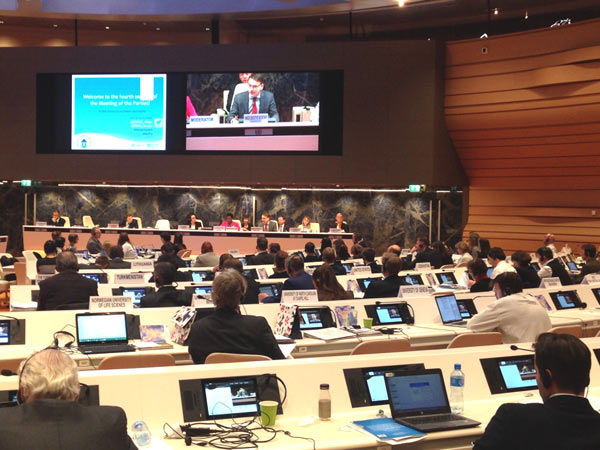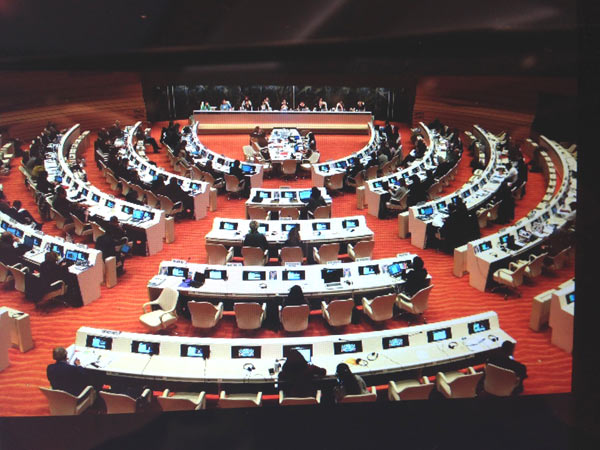FOURTH SESSION OF THE MEETING OF THE PARTIES TO THE PROTOCOL ON WATER AND HEALTH
The 4th session of the Meeting of the Parties to the Protocol on Water and Health to the Convention on the Protection and Use of Transboundary Watercourses and International Lakes (UNECE Water Convention) took place on November 14-16, 2016 in Geneva. The event gathered 200 participants.

Focus areas of the session:
- The Meeting of the Parties adopted an ambitious program of work for 2017-2019 focusing on two strategic areas: increasing resilience to climate change, and improving water, sanitation and hygiene in schools and health care facilities.
- A close correlation between the Protocol on Water and Health and the Sustainable Development Goals was repeatedly underlined. The Protocol may be used as a tool to implement the SDGs at the national level. This was discussed during the Special session on moving forward on the water and sanitation agenda in the pan-European region: the role of the Protocol on Water and Health in achieving the 2030 Agenda for Sustainable Development. The outcomes of the session were the following:
- Sustainable water supply is the key to economic development.
- Climate change may aggravate water supply problems, including through new migration flows and problems in the countries of origin, transit and destination.
- The water-ecosystems nexus is critically important.
- The Protocol on Water and Health is the forerunner of the SDGs and some SDGs try to keep in pace with the Protocol. That is why the pan-European region has set a high bar and is in the right way. Successful implementation of the Protocol will allow achieving SDGs in the region.
- The Protocol and its active institutional component. Policy and strategy papers. Substantial knowledge is the advantage of the Protocol.
- Intersectoral coordination, land use and education. Some call this the nexus; however the term “institutionalization” of joint tasks is also used.
- Transboundary coordination. Rivers without borders. Problems emerge among countries, but they mean nothing against potential and integrating cooperation.
- Cooperation in public health. The region has come a long way and may be proud of its achievements; it is therefore important to share knowledge in the context of SDGs. Authority and significance need to be increased.
- Initiatives and leaders are required.


- The implementation of the Protocol firstly implies the setting of targets to improve the water and health situation in each country of the region. During the meeting, the Parties to the Protocol and countries which have not still ratified it but contributing to the Protocol reported about the setting of these targets. It is worth to mention that the number of targets and their definition depends on specific conditions and needs of the country. To consult the countries, the “Collection of good practices and lessons learned on target setting and reporting under the Protocol on Water and Health” was prepared.
- Approximately 23% of the population of the pan-European region receives their drinking-water from small-scale systems. Such systems are more vulnerable to contamination. That is why the Protocol pays a specific attention to them. Two more publications were launched at the Meeting of the Parties, which highlight the range of instruments available to improve small-scale water supply and sanitation systems.
- 17% of water-related diseases are caused by contaminated water. The prevention and reduction of water-related diseases is a priority area under the Protocol.
- The participants informed about the progress towards the equitable access to water and sanitation, including the implementation of the “Equitable Access Score-card: Supporting policy processes to achieve the human right to water and sanitation”. This issue has become important as access to drinking water and sanitation was recognized in the human right to water by the UN General Assembly and Human Rights Council. To support efforts in this area, the “Guidance Note on the Development of Action Plans to Ensure Equitable Access to Water and Sanitation” was published.
- The compliance procedure is in place under the Protocol. This procedure efficiently implements a consultation process with countries which encounter difficulties in implementing the Protocol. Particularly, the Compliance Committee recently had consultations on the compliance procedure with Azerbaijan, Albania and Bosnia and Herzegovina. The Committee also prepared the “Interpretation of the provisions of the Protocol on Water and Health related to transboundary waters”, which may be a guide for Uzbekistan to accede to the Protocol. The main outcome of the paper is that after accession to the Protocol the Parties to the Water Convention will not have additional obligations related to transboundary waters, excluding one provision related to elimination of contradictions between available agreements and provisions of the Protocol.
- The Protocol in Central Asia: the head of the Kazakhstan’s delegation officially announced at the Meeting of the Parties that internal procedures have been finalized for the accession to the Protocol. It is expected that Kazakhstan will be a Party to the Protocol in the beginning 2017. In May 2016, the Ministry of Health of Turkmenistan officially informed the Protocol Secretariat about the intention to start the accession process to the Protocol. Kyrgyzstan and Tajikistan have not officially announced about possible accession, but these countries are setting national targets in accordance with the provisions of the Protocol on Water and Health. Thus, under the National Policy Dialogues both countries agreed on implementation of this tool. The Kyrgyz Republic adopted targets on water and health in 2013; the Republic of Tajikistan developed the targets in 2012-2013 and they are under approval now.
- The following program areas were adopted for 2017-2019:
- Program area 1 – Improving governance for water and health: support for setting targets and implementing measures
- Program area 2 – — Prevention and reduction of water-related diseases
- Program area 3 – Institutional water, sanitation and hygiene
- Program area 4 – Small-scale water supplies and sanitation
- Program area 5 – Safe and efficient management of water supply and sanitation systems
- Program area 6 – Equitable access to water and sanitation: translating the human right to water and sanitation into practice
- Program area 7 – Increasing resilience to climate change
- Program area 8 – Assistance to support implementation at the national level
- Program area 9 – Compliance procedure
D.R.Ziganshina
Deputy Director, SIC ICWC
|